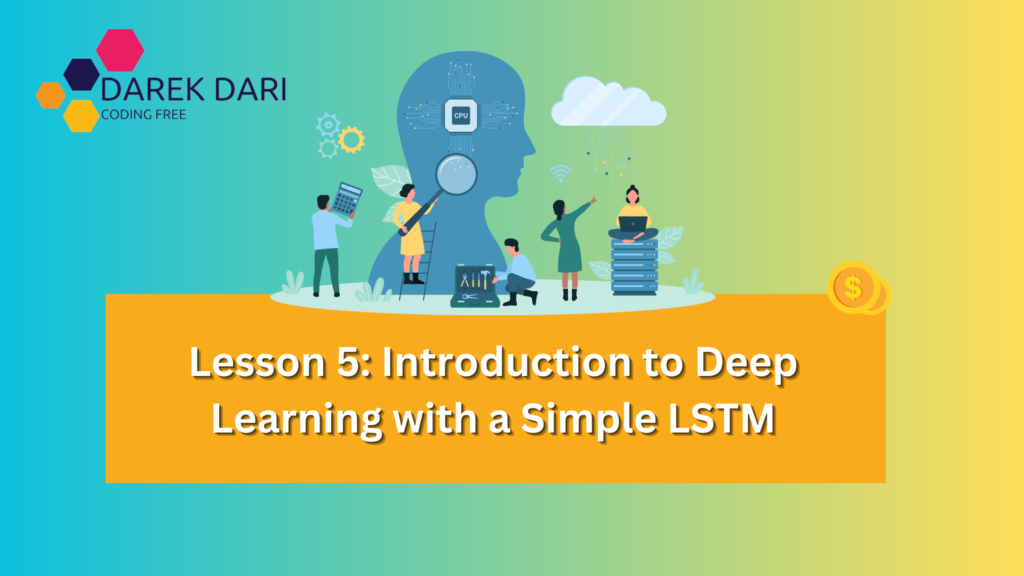
Table of Contents
Introduction
This notepad utilizes the temporal arrangement of the data.
Considering the anticipated prevalence of sequential Deep Learning models in this contest, I have devised a simple LSTM design to kickstart our efforts.
But don’t forget to check:
- Lesson 1: Best Deep Learning Tutorial for Beginners 2024
- Lesson 2: Best Pytorch Tutorial for Deep Learning
- Lesson 3: Best Transformers and BERT Tutorial with Deep Learning and NLP
- Lesson 4: Best Deep Reinforcement Learning Course
- Lesson 5: Introduction to Deep Learning with a Simple LSTM
The settings are configured with fundamental values, leaving ample room for enhancement and refinement.
The script is derived from past endeavors, and although certain functions come with explanations, they might be a bit out of date.
If you find this beneficial, kindly think about giving it an upvote before making any modifications!
This article exploits the time series format of the data.
What is LSTM and why is it used?
Hello there! Imagine you’re teaching a computer to analyze and anticipate patterns in a series of events, such as stock prices over time or the words in a sentence. Well, that’s where Long Short-Term Memory (LSTM) comes into play.
Think of LSTM as a special kind of intelligent network that takes inspiration from how our own memory functions.
It excels at retaining important information from earlier parts of a sequence, even amidst a lot of other information. It achieves this by utilizing clever gates to determine what to remember, what to forget, and what to focus on in the present moment.
This makes LSTM incredibly useful for various tasks where comprehending the context of past events is crucial, like predicting future trends or understanding the meaning of a sentence.
It’s like giving the computer a memory boost, enabling it to make more intelligent predictions and decisions based on what it has learned so far.
stock predictor
lstm neural network
lstm architectures
What is difference between LSTM and RNN?
When you’re trying to piece together a story or a series of events, it’s crucial to recall what happened earlier to make sense of the current situation.
Recurrent Neural Networks (RNNs) operate in a similar way in the realm of AI, acting as your brain to keep track of the unfolding narrative step by step.
Long Short-Term Memory (LSTM), on the other hand, serves as an enhanced version of RNNs. It excels in retaining information from a distant past in the sequence, making it ideal for tasks such as comprehending lengthy text passages or forecasting stock prices over an extended period.
Essentially, LSTM equips AI with a superior and more expansive memory capacity.
While RNNs are effective for simpler tasks that require remembering a few steps back, LSTM steps in when dealing with a wealth of context.
It’s akin to distinguishing between recalling yesterday’s breakfast and recollecting a detailed story from years ago.
Why LSTM is better than CNN?
LSTMs and CNNs each have their own strengths and are suited for different tasks. LSTMs excel in handling sequential data such as time series prediction and natural language processing.
They are specifically designed to retain information over long periods, making them ideal for identifying patterns in sequences of events or words.
Here’s a table comparing LSTM and CNN:
| LSTM | CNN | |
|---|---|---|
| Primary Use | Sequential data, such as time series or text | Image recognition, spatial data, such as images or maps |
| Memory | Long-term memory, remembers past information | Short-term memory, focuses on local patterns |
| Architecture | Recurrent neural network | Convolutional neural network |
| Operation | Sequential processing of input data | Parallel processing of local features |
| Strengths | Effective at capturing long-range dependencies | Excellent at detecting spatial patterns in data |
| Weaknesses | More complex to train and prone to vanishing gradients | Less effective for sequential data |
| Applications | Natural language processing, time series prediction | Image classification, object detection |
On the other hand, CNNs are experts in image recognition and spatial data analysis. They are specifically engineered to identify patterns in grid-like data, like images, by scanning them with filters to detect features.
Rather than one being superior to the other, it’s more about selecting the right tool for the job at hand. If you are working with sequences, LSTMs are the way to go.
If your focus is on images or spatial data, CNNs are the preferred choice. And in some cases, you may even combine both to tackle exceptionally complex problems!
pytorch lstm
long short term memory neural network
long short-term memory neural networks
Is LSTM an algorithm or model?
LSTM, a neural network architecture, is a specialized model ideal for tasks involving sequential data like time series prediction, natural language processing, and speech recognition.
It belongs to the family of recurrent neural networks (RNNs), designed to handle sequential data by maintaining an evolving internal state.
With its capability to capture long-range dependencies and address vanishing gradient issues, LSTM stands out as a popular and widely utilized architecture in the realm of RNNs.
Here’s a simple code example demonstrating how to create and train an LSTM model using the Keras library in Python for a basic sequential data prediction task:
import numpy as np
from keras.models import Sequential
from keras.layers import LSTM, Dense
# Generate some example sequential data
data = np.random.randn(100, 10, 1) # 100 sequences of length 10 with 1 feature
# Define the LSTM model
model = Sequential()
model.add(LSTM(50, input_shape=(10, 1))) # 50 LSTM units, input shape is (time steps, features)
model.add(Dense(1)) # Output layer with 1 neuron for regression
# Compile the model
model.compile(optimizer='adam', loss='mse') # Using mean squared error loss for regression
# Train the model
model.fit(data, np.random.randn(100, 1), epochs=10, batch_size=1)long short term memory
long short-term memory
lstm model
In this example:
- We generate some synthetic sequential data with 100 sequences, each of length 10, and containing 1 feature.
- We define a Sequential model in Keras and add an LSTM layer with 50 units. The input shape is specified as (10, 1) to match the dimensions of our input data.
- We add a Dense layer with 1 neuron as the output layer, suitable for regression tasks.
- We compile the model using the Adam optimizer and mean squared error loss function.
- Finally, we train the model on the generated data for 10 epochs.
This is a basic example to demonstrate the structure of an LSTM model in Keras. Depending on the specific task, you would modify the architecture, optimizer, loss function, and training parameters accordingly.
Explore our Data
Load the Dataset
DATA_PATH = "/kaggle/input/ventilator-pressure-prediction/" sub = pd.read_csv(DATA_PATH + 'sample_submission.csv') df_train = pd.read_csv(DATA_PATH + 'train.csv') df_test = pd.read_csv(DATA_PATH + 'test.csv') df = df_train[df_train['breath_id'] < 5].reset_index(drop=True)
df.head()
| id | breath_id | R | C | time_step | u_in | u_out | pressure | |
|---|---|---|---|---|---|---|---|---|
| 0 | 1 | 1 | 20 | 50 | 0.000000 | 0.083334 | 0 | 5.837492 |
| 1 | 2 | 1 | 20 | 50 | 0.033652 | 18.383041 | 0 | 5.907794 |
| 2 | 3 | 1 | 20 | 50 | 0.067514 | 22.509278 | 0 | 7.876254 |
| 3 | 4 | 1 | 20 | 50 | 0.101542 | 22.808822 | 0 | 11.742872 |
| 4 | 5 | 1 | 20 | 50 | 0.135756 | 25.355850 | 0 | 12.234987 |
Vizualisation of Data
for i in df['breath_id'].unique(): plot_sample(i, df_train)




dataset = VentilatorDataset(df) dataset[0]
Building a Deep Learning Model for Time Series Prediction
In this post, I’ll walk you through setting up a deep learning model to tackle a time series prediction problem. We’re going to leverage the sequential nature of our data to build a robust model. Here’s the plan:
Model Architecture
- 2-Layer MLP
- Bidirectional LSTM
- Prediction Dense Layer
This combination allows us to capture complex patterns in the data by using the strengths of both MLP and LSTM layers.
Training Components
- Utilities and Helpers: Various functions to streamline the training process.
- Metrics & Loss Function: In this competition, we’ll be scored based on the mean absolute error between the predicted and actual pressures during the inspiratory phase of each breath. The expiratory phase isn’t scored, so we’ll focus only on the inspiratory phase.
- Model Fitting: Training the model on our dataset.
- Prediction Generation: Creating predictions on the test set.
- k-Fold Cross-Validation: To ensure our model generalizes well, we’ll use k-fold cross-validation.
Configuration
We’ll use a Config class to manage all our training parameters. Here’s what it looks like:
class Config:
"""
Parameters used for training
"""
# General settings
seed = 42
verbose = 1
device = "cuda" if torch.cuda.is_available() else "cpu"
save_weights = True
# k-fold settings
k = 5
selected_folds = [0, 1, 2, 3, 4]
# Model settings
selected_model = 'rnn'
input_dim = 5
dense_dim = 512
lstm_dim = 512
logit_dim = 512
num_classes = 1
# Training settings
loss = "L1Loss" # currently not used
optimizer = "Adam"
batch_size = 128
epochs = 200
learning_rate = 1e-3
warmup_prop = 0
validation_batch_size = 256
first_epoch_eval = 0This configuration sets the stage for our training process. It includes general settings, k-fold cross-validation details, model specifics, and training parameters.
Training and Predictions
With our configuration set, we can now train our model and generate predictions:
pred_oof, pred_test = k_fold(
Config,
df_train,
df_test,
)
df_train["pred"] = pred_oof
for i in df_train['breath_id'].unique()[:5]:
plot_prediction(i, df_train)Here, we train our model using k-fold cross-validation. After training, we generate out-of-fold predictions and test set predictions. Finally, we visualize the predictions for the first few breath IDs.
This approach provides a strong baseline model for time series prediction, with plenty of room for further optimization and improvement. If you find this helpful, please give it an upvote before forking!





df_test['pred'] = pred_test for i in df_test['breath_id'].unique()[:5]: plot_prediction(i, df_test)





sub['pressure'] = pred_test sub.to_csv('submission.csv', index=False)
Conclusion
Our exploration into time series prediction using deep learning has shown the importance of combining creativity with attention to detail.
By combining a 2-layer MLP with bidirectional LSTM, we have successfully uncovered intricate patterns in our data, setting a strong foundation for predictive modeling.
With the help of the versatile Config class, we have efficiently managed parameters, allowing us to adjust and improve our approach as necessary.
Looking forward, our dedication to pushing the boundaries of time series prediction remains steadfast. With each step, we aim to not only improve the accuracy and reliability of our models but also deepen our understanding of the underlying dynamics.
Equipped with the knowledge gained from our journey so far, we are ready to explore new possibilities and lead advancements in deep learning-based forecasting.




3 Comments
Nawel · June 7, 2024 at 6:23 pm
Bonjour
I have a difficult to exécute m’y model with bilstm_crf python to système REN un arabica langage. My système cantine exécute model fit().
Please Can you help me please ?
Thanks
Writer1 · June 8, 2024 at 9:45 pm
please send me your code via email: daridarek1@gmail.com
Ill see it and if I found the solution ill text you
Lesson 2: Best Pytorch Tutorial For Deep Learning · October 24, 2024 at 10:26 am
[…] Lesson 5: Introduction to Deep Learning with a Simple LSTM […]